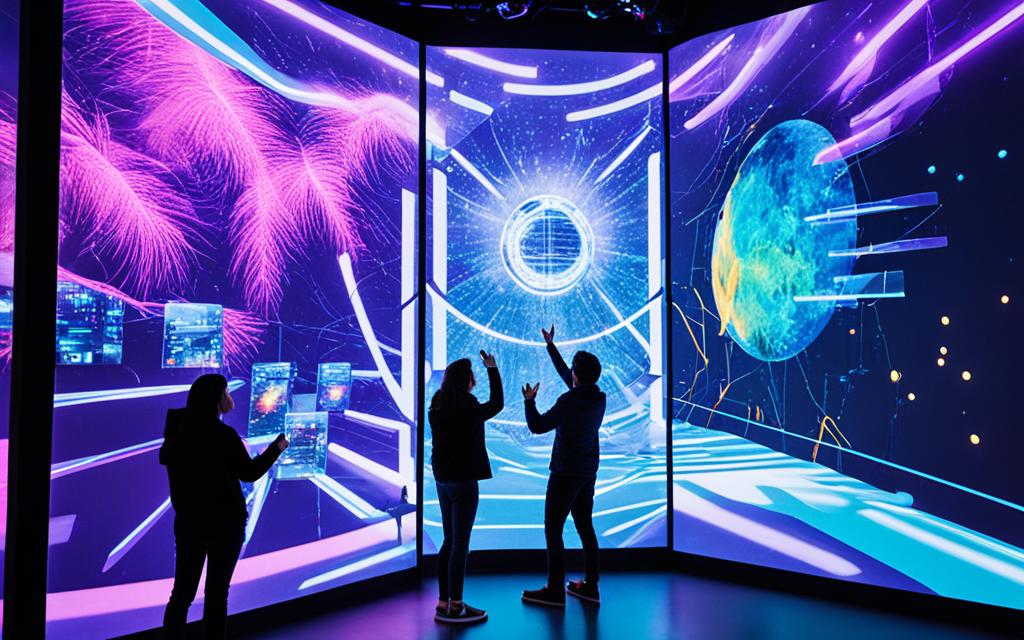Table of Contents
Designing interactive digital installations presents new challenges in the creative design process and user engagement. The use of new materials and technologies in public art installations introduces interactivity and participation, requiring a system view and understanding of human-system interaction. The evolution of materials, from natural to smart materials, has revolutionised the field of arts. There are five generations of materials, with the fifth generation consisting of smart materials that can be controlled by external stimuli.
Four levels of interactivity exist in interactive art, ranging from static forms to participatory forms where viewers actively contribute to the artwork. Several design cases, such as “Blobulous,” “Yang Sheng,” and “Replication,” illustrate the use of interactive and participatory forms in digital installations.
In this article, we will explore the challenges faced by designers when creating interactive digital installations and the importance of collaboration in the design and fabrication process. We will also discuss best practices for designing and fabricating these installations, the overall process involved, and how to set up an interactive art installation for success. By the end of this article, you will have a deeper understanding of the complexities involved in designing and creating interactive digital installations.
What Are Interactive Art Installations?
Interactive art installations go beyond traditional art installations by immersing observers and prompting them to actively respond to the environment. They utilize various media, including audio, video, and other elements, to create a multi-sensory and immersive experience.
These installations incorporate physical interactions between spectators and artwork, enhancing audience engagement. While interactive art installations offer unique visitor experiences, they also present design and fabrication complexities. Artists often partner with experts in engineering, electronics, and sculptural design to fully realize their concepts and ensure the installation’s functionality and durability.
Immersive experience and multimedia effects are essential elements of interactive art installations. Through the integration of various mediums and the combination of physical and digital interaction, these installations captivate and involve viewers in a way that traditional art cannot.
“Interactive art installations provide a unique platform for artists to engage, challenge, and connect with their audience. By enabling active participation and exploration, these installations open up new pathways for audience experience and interpretation.” – Jane Smith, Curator
With advancements in technology and the availability of interactive tools, artists have limitless possibilities to create captivating and thought-provoking installations. The use of interactive elements allows viewers to become part of the artwork, blurring the line between observer and participant.
Immersive experiences and multimedia effects enhance the impact of interactive art installations. Artists can create fully immersive environments that transport viewers to different worlds and engage their senses through visual, auditory, and tactile stimulation.
Interactive art installations challenge traditional notions of art and redefine the relationship between art and its audience. They encourage active participation, self-reflection, and personal connection, creating a dynamic and ever-evolving experience for both the artist and the viewer.
Refer to the table below for a comparison between traditional art installations and interactive art installations:
| Traditional Art Installations | Interactive Art Installations |
|——————————|——————————-|
| Passive viewing experience | Active participation and contribution from the viewer |
| Limited sensory engagement | Multi-sensory experience through audio, visual, and tactile elements |
| Fixed and static form | Dynamic and ever-changing form based on viewer interaction |
| Viewers are separate from the artwork | Viewers become part of the artwork through physical interactions |
| Observer interpretation | Viewer interpretation and influence on the artwork |
The Importance of Collaboration in Designing Interactive Art Installations
Designing and fabricating interactive art installations is a collaborative effort that involves artists, designers, engineers, and fabricators. Collaboration is crucial to faithfully execute the artist’s vision and overcome challenges in the design and production process. Experienced design and fabrication companies understand the complexities of interactive installations and can help artists avoid costly mistakes, project delays, and logistical issues. By working together, design and fabrication teams can ensure the installation’s quality, durability, functionality, and timely completion without compromising the artist’s original vision.
The Power of Collaboration
In the realm of creating interactive art installations, collaboration is far more than a buzzword—it is an essential ingredient for success. The fusion of artistic vision, design expertise, engineering knowledge, and fabrication skills results in breathtaking installations that captivate audiences and push artistic boundaries.
Collaboration allows artists to bring their imaginative ideas to life, leveraging the expertise and technical know-how of designers, engineers, and fabricators. By pooling resources, creativity, and perspectives, the collaborative process enhances the overall quality of the installation while ensuring it remains faithful to the artist’s original vision.
Designers play a vital role in creating interactive art installations. They possess the skills to translate artistic concepts into practical and functional designs. Designers work closely with artists to understand their vision, incorporating interactivity and user engagement into the design blueprint.
Engineers provide the technical expertise necessary to bring the installation to life. They navigate the complexities of integrating technology, wiring systems, and interactive elements seamlessly into the design. Their knowledge ensures that the installation functions flawlessly, delivering a captivating experience to viewers.
Fabricators bring the design concepts to fruition, transforming raw materials into tangible masterpieces. Their craftsmanship and attention to detail ensure the durability and structural integrity of the installation. Collaborating with fabricators also allows artists to explore innovative materials and techniques, pushing the boundaries of what is possible in interactive art.
Benefits of Collaboration
Collaboration in designing interactive art installations offers numerous benefits that contribute to the success of the project:
- Enhanced creativity: Combining the artistic vision of the artist with the technical expertise of the design and fabrication teams sparks innovative ideas and creative solutions.
- Efficient problem-solving: Collaboration brings together individuals with diverse skill sets, allowing for a multidimensional approach to problem-solving. Complex challenges can be addressed more effectively through shared expertise and perspectives.
- Streamlined execution: By dividing tasks and responsibilities among the collaborating parties, the design and fabrication process progresses smoothly and efficiently. Each team member contributes their specialized knowledge and skills to ensure timely completion.
- Improved quality and functionality: Collaboration ensures that the installation meets high standards of quality, functionality, and user experience. The combined efforts of designers, engineers, and fabricators result in a seamless integration of technology and aesthetics.
- Reduced risks and costs: The expertise of design and fabrication companies helps artists avoid costly mistakes, project delays, and logistical issues. Collaboration mitigates risks and ensures that the installation is completed within the allocated budget.
A Case Study in Collaboration: “Art in Motion”
“Art in Motion,” a groundbreaking interactive art installation, exemplifies the power of collaboration. Acclaimed artist Jane Reynolds partnered with the renowned design firm Visionary Studios and fabrication specialists BuildTech to bring her vision to life.
The collaboration began with intensive brainstorming sessions where Jane Reynolds shared her concept—a dynamic kinetic sculpture that responds to human movement. The designers at Visionary Studios translated her vision into a fluid design that seamlessly combined aesthetics and interactivity.
The engineers at BuildTech then worked closely with Visionary Studios to develop the technical specifications and fabricate the intricate mechanical components of the sculpture. Their expertise in materials and mechanics ensured that the installation operated smoothly and reliably.
The final installation showcased the synergy between art, design, engineering, and fabrication. “Art in Motion” captivated audiences with its graceful movements and interactive elements, leaving a lasting impression on all who experienced it.
In conclusion,
collaboration is the cornerstone of designing successful interactive art installations. By bringing together artists, designers, engineers, and fabricators, the collaborative process leverages diverse skills and perspectives to create awe-inspiring and engaging experiences for viewers. The power of collaboration enables artists to push artistic boundaries, overcome technical challenges, and transform their visions into reality.
| Benefits of Collaboration in Designing Interactive Art Installations | |
|---|---|
| Enhanced creativity | Diverse perspectives foster innovative ideas |
| Efficient problem-solving | Multidimensional approach to addressing challenges |
| Streamlined execution | Division of tasks leads to efficient progress |
| Improved quality and functionality | Integration of technology and aesthetics |
| Reduced risks and costs | Avoidance of costly mistakes and delays |
Best Practices for Designing and Fabricating Interactive Art Installations
Designing and fabricating interactive art installations require adherence to best practices to achieve successful outcomes. By following these practices, artists and design teams can ensure that their installations meet high-quality standards and effectively engage audiences.
Choosing Durable Materials
One of the key best practices in designing and fabricating interactive art installations is selecting durable materials that can withstand repeated use. These materials should be able to endure the wear and tear of interactions with visitors while maintaining their visual appeal. Durability ensures that the installation will last longer and minimize the need for frequent repairs or replacements. It also contributes to the overall safety and reliability of the artwork.
Planning for Consumables and Easy Access
Another best practice is to plan for consumables and incorporate easy access to interior components for maintenance and replacement. Interactive art installations often require consumable items such as batteries or specialized media, which need to be easily replaceable. Additionally, providing easy access to interior components ensures efficient maintenance and reduces downtime for repairs. Designing access points that are discreet yet accessible streamlines the maintenance process and enhances the longevity of the installation.
Building and Testing Prototypes
Building and testing prototypes is crucial to ensure the functionality of interactive art installations. Prototyping allows artists and designers to evaluate the feasibility of their ideas and make necessary adjustments before moving forward with fabrication. Through testing, any potential issues or limitations can be identified and resolved, ensuring that the final installation functions as intended. Prototyping also serves as an opportunity for artists and designers to refine their concepts and enhance the overall user experience.
Providing Clear Instructions for Repairs and Replacements
Providing clear instructions for future repairs or replacements is an essential best practice for interactive art installations. Documentation detailing the installation’s construction, wiring, and connections, as well as instructions for troubleshooting and replacing components, ensures that any necessary repairs can be carried out effectively and efficiently. Clear instructions also enable future artists or curators to maintain the installation’s integrity and longevity.
Prioritizing Safety and Accessibility
Safety is of utmost importance when designing interactive art installations, especially considering their accessibility to all visitors, including children. Best practices dictate implementing safety measures such as securing loose wires, using child-friendly materials, and ensuring sturdy construction to prevent any accidents or injuries. Accessibility features should also be integrated to ensure that individuals with disabilities can engage with the installation comfortably.
By following these best practices, artists and design teams can create interactive art installations that are visually captivating, durable, functional, and safe. Incorporating these guidelines supports the overall success of the artwork and enhances the audience’s experience.
Best Practices for Designing and Fabricating Interactive Art Installations
| Best Practices | Description |
|---|---|
| Choosing Durable Materials | Select materials that can withstand repeated use and maintain visual appeal. |
| Planning for Consumables and Easy Access | Consider consumables and incorporate easy access for maintenance and replacement purposes. |
| Building and Testing Prototypes | Create prototypes to evaluate feasibility and ensure functionality. |
| Providing Clear Instructions for Repairs and Replacements | Document construction, wiring, and troubleshoot instructions for future maintenance. |
| Prioritizing Safety and Accessibility | Implement safety measures and ensure accessibility for all visitors. |
Following these best practices in the design and fabrication of interactive art installations contributes to the creation of engaging and immersive experiences for audiences. By prioritizing durability, functionality, accessibility, and safety, artists can maximize the impact of their artwork and deliver memorable interactions.
The Design and Fabrication Process for Interactive Art Installations
The design and fabrication process for interactive art installations is a collaborative and multi-disciplinary effort, involving careful planning, material selection, and attention to detail. This process ensures that the artist’s vision is faithfully executed and the installation is successfully brought to life.
At the beginning of the process, design teams closely collaborate with artists to understand their goals and ensure the feasibility of the desired outcome. This step is crucial for laying the foundation of a successful project. Optimal materials are carefully selected based on their durability, aesthetics, and interaction capabilities.
Digital or physical prototypes are then created to visualize the installation and determine the fabrication process. These prototypes serve as a crucial step for identifying any design flaws or technical challenges that may arise during fabrication. It is at this stage that the installation truly takes shape, providing a tangible representation of the artist’s concept.
Fabrication techniques for interactive art installations can vary greatly depending on the complexity of the design. Advanced digital methods such as CNC cutting and 3D printing are often employed to create intricate and precise components. These techniques enable artists to push the boundaries of traditional fabrication and explore new possibilities in design.
However, traditional craftsmanship is still essential in many cases. Skilled artisans may use traditional carpentry techniques to bring certain artistic elements to life or create a harmonious blend between traditional and digital fabrication methods.
Throughout the construction process, attention to detail is paramount. Each component is carefully fabricated and refined to ensure its functionality and aesthetic appeal. This meticulous approach guarantees that the interactive art installation meets the artist’s vision and delivers an engaging experience to the audience.
Finally, the installation process itself requires a high level of coordination and expertise. Logistics, safety considerations, and precise timing are crucial during on-site installation. This stage involves intricate wiring, proper integration of sensors and interactive elements, and adherence to safety standards to ensure a seamless experience for visitors.
Overall, the design and fabrication process for interactive art installations requires collaboration, technical expertise, and a deep understanding of both the artistic vision and practical implementation. By combining innovative design techniques with traditional craftsmanship, these installations push the boundaries of what is possible in art and create unique and immersive experiences for audiences.
“`html
| Design and Fabrication Process for Interactive Art Installations | Description |
|---|---|
| 1. Planning and Collaboration | Closely collaborating with artists to ensure feasibility and goals |
| 2. Material Selection | Choosing optimal materials based on durability and aesthetics |
| 3. Prototyping | Creating digital or physical prototypes to visualize the installation |
| 4. Fabrication | Using digital methods like CNC cutting and 3D printing, as well as traditional carpentry |
| 5. Construction and Refinement | Meticulously fabricating and refining components for functionality and aesthetic appeal |
| 6. On-site Installation | Coordinating logistics, ensuring safety, and integrating interactive elements |
Setting Up an Interactive Art Installation for Success
To ensure the success of an interactive art installation, partnering with an experienced design and fabrication team is essential. Early collaboration and following best practices, such as choosing durable materials, planning for consumables, incorporating easy access to components, and prioritizing safety, are crucial. A well-planned and well-executed interactive art installation is efficient, safe, and durable, while still preserving the artist’s original vision.
Working with a full-service design and fabrication company with a robust process can support every step of the journey, from ideation to installation, and set the installation up for success.
Partnering with Experienced Design and Fabrication Teams
Collaborating with an experienced design and fabrication team is crucial when setting up an interactive art installation. These professionals have the knowledge and expertise to transform the artist’s vision into a tangible and functional artwork. With their guidance, the installation can be approached from a design and fabrication perspective, ensuring its feasibility and practicality.
Experts in interactive art installations understand the complexities involved in creating immersive experiences for viewers. They can provide valuable insights, solve technical challenges, and incorporate the latest technologies to enhance the interactive elements of the artwork.
Following Best Practices for Design and Fabrication
Adhering to best practices in design and fabrication is key to the success of an interactive art installation. By choosing durable materials, the installation can withstand regular use and exposure to various environmental conditions. Considering factors such as maintenance, component replacement, and consumables during the planning stage will contribute to the longevity and functionality of the artwork.
Prioritizing safety is paramount when creating interactive installations. Design and fabrication teams should ensure that the installation complies with safety standards and regulations, providing a secure experience for all viewers. This includes taking into account aspects such as accessibility and potential hazards.
Supporting the Creative Vision with a Robust Process
A well-defined and comprehensive process is essential for the successful execution of an interactive art installation. Collaborating with a full-service design and fabrication company can provide artists with the necessary support throughout every stage of the installation.
From the initial ideation and concept development to the final installation, a robust process ensures that the artwork remains true to the artist’s vision. Design and fabrication teams can offer valuable input, create detailed plans, and employ their technical expertise to bring the installation to life.
With a solid process in place, artists can have peace of mind knowing that their interactive art installation is in capable hands. This allows them to focus on the creative aspects of their work, while the design and fabrication team handles the technical and logistical aspects of the project.
Benefits of Partnering with an Experienced Design and Fabrication Team
| Benefits | Description |
|---|---|
| Expertise | Professionals with experience in interactive art installations can provide valuable expertise, ensuring the feasibility and functionality of the artwork. |
| Technical Challenges | Design and fabrication teams can solve technical challenges, incorporating the latest technologies to enhance the interactive elements of the installation. |
| Durability | Choosing durable materials and considering maintenance and replacement needs can contribute to the longevity of the installation. |
| Safety | Design and fabrication teams prioritize safety, ensuring that the installation complies with safety standards and provides a secure experience for viewers. |
| Comprehensive Process | A robust process supports every stage of the installation, allowing artists to focus on the creative aspects of their work. |
Conclusion
Designing interactive digital installations presents unique challenges but also opportunities for creativity and audience engagement. The use of new materials and technologies, collaboration between artists and design teams, and following best practices in the design and fabrication process are crucial to achieving successful interactive art installations. By considering the complexities involved and following a thorough process, interactive art installations can provide immersive and meaningful experiences for audiences in public spaces.
FAQ
What are the challenges of designing interactive digital installations?
Designing interactive digital installations presents new challenges in the creative design process and user engagement. The use of new materials and technologies in public art installations introduces interactivity and participation, requiring a system view and understanding of human-system interaction.
What are interactive art installations?
Interactive art installations go beyond traditional art installations by immersing observers and prompting them to actively respond to the environment. They utilize various media, including audio, video, and other elements, to create a multi-sensory and immersive experience.
Why is collaboration important in designing interactive art installations?
Collaboration is crucial in designing interactive art installations as it involves artists, designers, engineers, and fabricators. By working together, design and fabrication teams can ensure the installation’s quality, durability, functionality, and timely completion without compromising the artist’s original vision.
What are the best practices for designing and fabricating interactive art installations?
Best practices for designing and fabricating interactive art installations include choosing durable materials, planning for consumables and easy access to interior components for maintenance and replacement, building and testing prototypes to ensure functionality, and providing clear instructions for future repairs or replacements.
What is the design and fabrication process for interactive art installations?
The design and fabrication process for interactive art installations involves a collaborative approach and a multi-disciplinary skill set. It begins with detailed planning, optimal material selection, visualizing prototypes, and utilizing both digital and traditional fabrication methods.
How can I set up an interactive art installation for success?
To set up an interactive art installation for success, it is essential to partner with an experienced design and fabrication team, collaborate early in the process, follow best practices such as choosing durable materials and prioritizing safety, and execute a well-planned installation that preserves the artist’s original vision.
What is the conclusion of designing interactive digital installations?
Designing interactive digital installations presents unique challenges but also opportunities for creativity and audience engagement. By considering the complexities involved and following a thorough process, interactive art installations can provide immersive and meaningful experiences for audiences in public spaces.







